Popular categories
Looking for a yarn?
DROPS 73-9
Jacket in DROPS Angora-Tweed or Lima or Soft tweed.
Change language:
English (UK/cm), Greece- English (UK/cm), Greece
- Česky - not translated
- Dansk
- Deutsch
- Eesti keel - not translated
- English (UK/cm)
- English (US/in)
- Español
- Français
- Íslenska - not translated
- Italiano - not translated
- Magyar
- Nederlands
- Norsk
- Polski
- Português
- Suomi
- Svenska
- English (UK/cm), Bulgaria
- English (UK/cm), Croatia
- English (UK/cm), Latvia
- English (UK/cm), Lithuania
- English (UK/cm), Romania
- English (UK/cm), Slovenia
- Česky, Slovakia - not translated
This pattern still doesn't have a name. Suggest one!
Sizes: S - M - L - XL - XXL
Finished measurements:
Bust: 96-104-112-120-128 cm
Hem: 104-112-120-128-136 cm
Materials:
DROPS ANGORA-TWEED from Garnstudio
550-600-650-700-750 gr nr 15, periwinkle.
Or use:
DROPS LIMA from Garnstudio
800-900-950-1050-1100 gr nr 4434, purple.
Or use:
DROPS SOFT TWEED from Garnstudio
650-700-750-800-850 gr nr 15, purple rain
DROPS 5 mm needles, or sizes needed to obtain correct gauge.
-------------------------------------------------------
Alternative Yarn – See how to change yarns here
Yarn Groups A to F – Use the same pattern and change the yarn here
Yarn usage using an alternative yarn – Use our yarn converter here
-------------------------------------------------------
You might also like...
Pattern instructions
Rib: * K 2, P 2*, repeat from * - *.
Garter st, when knitting flat: Knit all sts, all rows.
Knitting tips (for neck shaping):
All decs are made on right side rows.
Dec 1 st inside of 1 edge st as follows:After 1 edge st: Slip 1 as if to knit, K 1, psso.
Before 1 edge st: K 2 tog.
Back: Cast on 124-132-140-152-160 sts in Angora-Tweed or Lima. Knit rib, beginning and ending right side rows with K 1 (edge st knit in garter st throughout), P 2. When the piece measures 10 cm change to stockinette st, decreasing 24-24-24-28-28 sts evenly distributed on the first row = 100-108-116-124-132 sts.
When the piece measures 25 cm dec 1 st at each side every 10 cm a total of 3 times = 94-102-110-118-126 sts.
When the piece measures 55-56-57-58-60 cm bind off for armhole at each side every other row: 4 sts 1 time, 3 sts 1-1-1-2-2 times, 2 sts 1-2-4-4-5 times and 1 st 3-4-3-3-4 times = 70-72-74-76-78 sts. When the piece measures 74-76-78-80-82 cm bind off the center 24-26-26-28-28 sts for the neck. Then bind off 1 st at each neck edge on the next row = 22-22-23-23-24 sts remain on each shoulder.
Bind off when the piece measures 76-78-80-82-84 cm.
Pocket lining: Cast on 26 sts in Angora-Tweed or Lima and knit stockinette st for 24 cm. Put sts on a st holder and knit a second pocket lining.
Right front: Cast on 85-89-93-97-101 sts in Angora-Tweed or Lima. Knit rib as follows from center front edge (right side row): K 2 (edge sts knit in garter st throughout), * K 2, P 2 *, repeat from * - * and end with K 2 + K 1 (edge st knit in garter st throughout).
When the piece measures 10 cm establish pattern as follows from center front edge (right side row): K 2 (edge sts knit in garter st throughout), 20 sts rib and stockinette st over the remaining sts, decreasing 13 sts evenly distributed over the stockinette sts on the first row = 72-76-80-84-88 sts.
When the piece measures 20-21-22-23-24 cm knit the next row as follows from center front edge: K 2 (edge sts knit in garter st), 20 sts rib, 8-10-11-12-14 sts in stockinette st, put the next 26 sts on a st holder for pocket opening, and slip 26 sts from one pocket lining onto right hand needle, 16-18-21-24-26 sts in stockinette st.
Read the entire next section before knitting:
Continue in stockinette st with 20 sts rib and 2 sts in garter st at the center front. At the same time when the piece measures 25 cm dec 1 st at the side every 10 cm a total of 3 times. At the same time when the piece measures 36-38-40-42-44 cm put the 22 edge st at the center front on a st holder (the collar will be knit and sewn to body later). Cast on 1 new sts at the center front edge (knit this edge st in garter st throughout). Continue with stockinette st, and dec 1 st for the neck inside the edge st every 6 rows 14-15-15-16-16 times - see knitting tips.
At the same time when the piece measures 55-56-57-58-60 cm bind off for armhole at the side as on back. After all armhole and neck shaping is complete 22-22-23-23-24 sts remain on each shoulder. Bind off when the piece measures 76-78-80-82-84 cm.
Collar: Put sts on st holder back on needles = 22 sts. Continue in established rib keeping 2 sts at the center front edge in garter st throughout. At the same time on 1st right side row inc 1 st inside 5 edge sts at each side (inc by pulling up a st from the previous row). Inc 1 st at each side every 6 rows a total of 16 times = 54 sts on needles - the increased sts are knit in the rib as you go along. When the collar measures approx. 38 cm put all sts on a st holder. Sew collar to edge sts on front from right side.
Pocket-edge: Put sts from st holder for pocket opening (26 sts) back on needles. Knit rib (with 2 sts at each edge in garter st) for 3 cm, bind off. Fold pocket lining double and sew cast-on edge to bottom edge of pocket edge. Sew sides of pockets.
Left front: Cast on and knit the same as the right reversing shaping.
Sleeve: Cast on 46-50-50-54-54 sts in Angora-Tweed or Lima. Knit rib for 16 cm. Change to stockinette st - and inc 1 st at each side every 5-5-4-4-4 rows a total of 15-15-16-16-16 times = 76-80-82-86-86 sts.
When sleeve measures 48-47-45-43-42 cm bind off for sleeve cap at each side every other row: 3 sts 1 time, 2 sts 4-4-4-3-3 times, 1 st 4-5-8-13-14 times, then bind off 2 sts each side until the piece measures 58 cm and then 3 sts 1 time. The piece measures approx. 59 cm, bind off the remaining sts.
Belt: Cast on 14 sts and knit rib with 2 sts in garter st at each side. Bind off when belt measures approx. 120-150 cm.
Assembly: Sew shoulder seams.
Collar: Pick up all sts from st holders on fronts + 26 sts over back = 134 sts. Knit rib over all sts - match up rib on fronts - at the same time inc 1 st inside the 5 outermost sts at each side at the center front as before every 6 rows 4 times - knit the increased sts in the rib. Bind off in rib when the collar measures approx. 10 cm at center back. Sew in sleeves. Sew sleeve and side seams using edge sts as a seam allowance.
Belt loops: Make 2 small twisted cords with double strands of yarn approx. 5 cm long. Sew to side seams at each side on the cardigan approx. 30-40 cm from lower edge.
Diagram
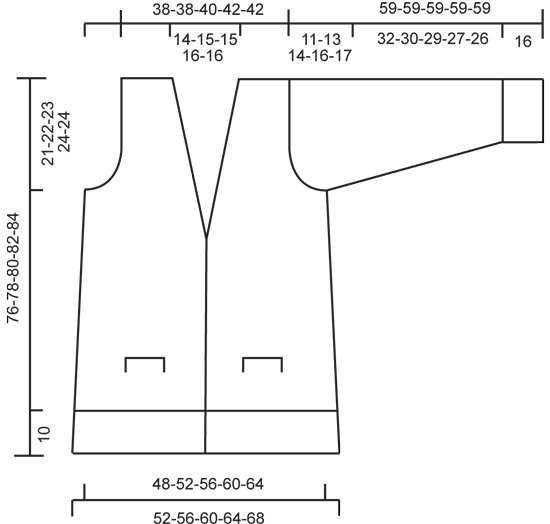
What can you do with our patterns? You can share DROPS patterns online, using the pattern original picture, materials, name and number. But you are NOT ALLOWED to reproduce the complete pattern digitally in any way. Yarn stores are welcome to use the DROPS pattern database to promote the sale of our assortment. You can print out our patterns, make as many copies as you’d like. The only thing we ask is that you don't make any changes / additions to the original printed document. And that the patterns according to the DROPS philosophy are given out to the consumers for free. Editorials that wish to publish our patterns in printed books or magazines can contact us for more information. The sale of garments based on DROPS patterns is permitted as long as they are sold as single items or per order. Further commercial use of the patterns is not permitted. It has to be clearly stated that the garment is made based on a design from DROPS DESIGN. The use of clothing labels of which DROPS DESIGN forms part is conditioned by the inclusion of the following text: “A DROPS DESIGN made by …..”. The use of DROPS photos for marketing purposes/sales is only permitted in connection with the use/sale of DROPS products. The photos may not be cut or edited and the logo should be clearly visible.
We reserve the right to withdraw the permission for use of our patterns at any time, notwithstanding the reason.
Each of our patterns has specific tutorial videos to help you.
These step-by-step tutorials might also help you:
Why is the knitting/crochet tension so important?
Knitting tension is what determines the final measurements of your work, and is usually measured per 10 x 10 cm. It is provided like so: number of stitches in width x number of rows in height - eg: 19 stitches x 26 rows = 10 x 10 cm.
The knitting tension is very individual; some people knit/crochet loosely while others work tightly. You adjust the knitting tension with the needle size, which is why the suggested needle size is only meant as a guide! You need to adjust this (up or down) to ensure that YOUR knitting tension matches the knitting tension provided in the pattern. If you work with a different knitting tension than provided you will have a different yarn consumption, and your work will have different measurements than what the pattern suggests.
The knitting tension also determines which yarns can replace each other. As long as you achieve the same knitting tension you can replace one yarn with another.
See DROPS lesson: How to measure your tension/gauge
See DROPS video: How to make a gauge tension swatch
How do I know how many balls of yarn I need?
The required amount of yarn is provided in grams, eg: 450 g. To calculate how many balls you’ll need you first need to know how many grams are in 1 ball (25g, 50g or 100g). This information is available if you click on the individual yarn quality on our pages. Divide the amount required with the amount of each ball. For example, if each ball is 50g (the most common amount), the calculation will be as follows: 450 / 50 = 9 balls.
Can I use a different yarn than what the pattern suggests?
The important thing when changing from one yarn to another is that the knitting/crochet tension remains the same. This is so that the measurements of the finished piece will be the same as on the sketch provided. It is easier to achieve the same knitting tension using yarns from the same yarn group. It is also possible to work with multiple strands of a thinner yarn to achieve the knitting tension of a thicker one. Please try our yarn converter. We recommend you to always work a test swatch.
Please NOTE: when changing yarn the garment might have a different look and feel to the garment in the photo, due to individual properties and qualities of each yarn.
See DROPS lesson: Can I use a different yarn than the one mentioned in the pattern?
What are the yarn groups?
All our yarns are categorised into yarn groups (from A to F) according to thickness and knitting tension – group A contains the thinnest yarns and group F the thickest. This makes it easier for you to find alternative yarns to our patterns, should you wish to switch yarn. All yarns within the same group have a similar knitting tension and can easily replace each other. However, different yarn qualities have different structures and properties which will give the finished work a unique look and feel.
How do I use the yarn calculator?
At the top of all our patterns you’ll find a link to our yarn calculator, which is a helpful tool should you wish to use a different yarn than suggested. By filling in the yarn quality you wish to replace, the amount (in your size) and number of strands, the calculator will present good alternative yarns with the same knitting tension. Additionally it will tell you how much you’ll require in the new qualities and whether you’ll need to work with multiple strands. Most skeins are 50g (some are 25g or 100g).
If the pattern is worked with multiple colours, every colour will have to be calculated separately. Similarly, if the pattern is worked with several strands of different yarns (for example 1 strand Alpaca and 1 strand Kid-Silk) you will have to find alternatives for each, individually.
Why do you show discontinued yarns in the patterns?
Since different yarns have different qualities and textures we have chosen to keep the original yarn in our patterns. However, you can easily find options among our available qualities by using our yarn calculator, or simply pick a yarn from the same yarn group.
It is possible that some retailers still have discontinued yarns in stock, or that someone has a few skeins at home that they would like to find patterns for.
The yarn calculator will provide both alternative yarn as well as required amount in the new quality.
What size should I knit?
If you think it's hard to decide what size to make, it can be a good idea to measure a garment you own already and like the size of. Then you can pick the size by comparing those measures with the ones available in the pattern's size chart.
You'll find the size chart at the bottom of the pattern.
See DROPS lesson: How to read size chart
Why do I get the wrong knitting tension with the suggested needle size?
The needle size provided in the pattern serves only as a guide, the important thing is to follow the knitting tension. And since knitting tension is very individual, you will have to adjust the needle size to ensure that YOUR tension is the same as in the pattern – maybe you’ll have to adjust 1, or even 2 needle sizes, up or down to achieve the correct tension. For this, we recommend that you work test swatches.
Should you work with a different knitting tension than the one provided, the measurements of the finished garment might deviate from the measurement sketch.
See DROPS lesson: How to measure your tension/gauge
See DROPS video: How to make a tension/gauge swatch
Why is the pattern worked top-down?
Working a garment top-down provides more flexibility and room for personal adjustment. For example it is easier to try the garment on while working, as well as making adjustments to length of yoke and shoulder caps.
The instructions are carefully explaining every step, in the correct order. Diagrams are adjusted to the knitting direction and are worked as usual.
How do I work according to a knitting diagram?
The diagram depicts all rows/rounds, and every stitch seen from the right side. It is read from bottom to top, from right to left. 1 square = 1 stitch.
When working back and forth, every other row is worked from the right side and every other row is worked from the wrong side. When working from the wrong side, the diagram will have to be worked reversed: from left to right, knit stitches are purled, purl stitches are knit etc.
When working in the round every round is worked from the right side and the diagram are worked from right to left on all rounds.
See DROPS lesson: How to read knitting diagrams
How do I work according to a crochet diagram?
The diagram depicts all rows/rounds, and every stitch seen from the right side. It is worked from bottom to top, from right to left.
When working back and forth every other row is worked from the right side: from right to left and every other row is worked from the wrong side: from left to right.
When working in the round, every row in the diagram are worked from the right side, from right to left.
When working a circular diagram you start in the middle and work your way outwards, counter clockwise, row by row.
The rows usually start with a given number of chain stitches (equivalent to the height of the following stitch), this will either be depicted in the diagram or explained in the pattern.
See DROPS lesson: How to read crochet diagrams
How do I work several diagrams simultaneously on the same row/round?
Instructions for working several diagrams after each other on the same row/round, will often be written like so: “work A.1, A.2, A.3 a total of 0-0-2-3-4 times". This means you work A.1 once, then A.2 is worked once, and A.3 is repeated (in width) the number of times provided for your size – in this case like so: S = 0 times, M = 0 times, L=2 times, XL= 3 times and XXL = 4 times.
The diagrams are worked as usual: begin with the first row in A.1, then work the first row in A.2 etc.
See DROPS lesson: How to read knitting diagrams
See DROPS lesson: How to read crochet diagrams
Why are the sleeves shorter in larger sizes?
The total width of the garment (from wrist-to-wrist) will be larger in the larger sizes, despite the actual sleeves being shorter. The larger sizes have longer sleeve caps and wider shoulders, so there will be a good fit in all sizes.
Where on the garment is the length measured?
The measurement sketch/schematic drawing provides information regarding the full length of the garment. If it’s a jumper or a jacket the length is measured from the highest point on the shoulder closest to the neckline, and straight down to the bottom of the garment. It is NOT measured from the tip of shoulder. Similarly, the length of yoke is measured from the highest point on the shoulder and down to where yoke is split into body and sleeves.
On a jacket measures are never taken along bands, unless specifically stated. Always measure inside band stitches when measuring the length.
See DROPS lesson: How to read a schematic drawing
What is a repeat?
Diagrams are often repeated on the round or in height. 1 repeat is the diagram the way it appears in the pattern. If it says to work 5 repeats of A.1 in the round, then you work A.1 a total of 5 times after/next to each other in the round. If it says to work 2 repeats of A.1 vertically/in height you work the entire diagram once, then begin again at the start and work the entire diagram one more time.
Why does the piece start with more chain stitches than it’s worked with?
Chain stitches are slightly narrower than other stitches and to avoid working the cast-on edge too tight, we simply chain more stitches to begin with. The stitch count will be adjusted on the following row to fit the pattern and measurement sketch.
Why increase before the rib edge when the piece is worked top-down?
The rib edge is more elastic and will contract slightly compared to, for example, stocking stitch. By increasing before the rib edge, you avoid a visible difference in width between the rib edge and the rest of the body.
Why increase in the cast-off edge?
It’s very easy to cast off too tightly, and by making yarn overs while casting off (and simultaneously casting these off) you avoid a too tight cast off edge.
See DROPS video: How to bind off with yarn overs (yo)
How do I increase/decrease on every 3rd and 4th row/round alternately?
To achieve an even increase (or decrease) you can increase on, for example: every 3rd and 4th row alternately, like so: work 2 rows and increase on the 3rd row, work 3 rows and increase on the 4th. Repeat this until the increase is complete.
See DROPS lesson: Increase or decrease 1 st on every 3rd and 4th row alternately
How can I work a jacket in the round instead of back and forth?
Should you prefer to work in the round instead of back and forth, you may of course adjust the pattern. You’ll need to add steeks mid-front (usually 5 stitches), and follow the instructions. When you would normally turn and work from the wrong side, simply work across the steek and continue in the round. At the end you’ll cut the piece open, pick up stitches to work bands, and cover the cut edges.
See DROPS video: How to knit steeks and cut open
Can I work a jumper back and forth instead of in the round?
Should you prefer to work back and forth instead of in the round, you may of course adjust the pattern so you work the pieces separately and then assemble them at the end. Divide the stitches for the body in 2, add 1 edge stitch in each side (for sewing) and work the front and back pieces separately.
See DROPS lesson: Can I adapt a pattern for circular needles into straight needles?
Why is the pattern slightly different than what I see in the photo?
Pattern repeats can vary slightly in the different sizes, in order to get the correct proportions. If you’re not working the exact same size as the garment in the photo, yours might deviate slightly. This has been carefully developed and adjusted so that the complete impression of the garment is the same in all sizes.
Make sure to follow instructions and diagrams for your size!
How do I make a women’s size garment into a men’s size one?
If you have found a pattern you like which is available in women’s size it’s not very difficult to convert it to men’s size. The biggest difference will be the length of sleeves and body. Start working on the women size that you think would fit across the chest. The additional length will be worked right before you cast off for the armhole/sleeve cap. If the pattern is worked top-down you can add the length right after the armhole or before the first decrease on sleeve.
Regarding additional yarn amount, this will depend on how much length you add, but it is better with a skein too many than too few.
How do I prevent a hairy garment from shedding?
All yarns will have excess fibres (from production) that might come off as lint or shedding. Brushed yarns (ie hairier yarns) have more of these loose, excess fibres, causing more shedding.
Shedding also depends on what is worn under or over the garment, and whether this pulls at the yarn fibres. It’s therefore not possible to guarantee that there will be no shedding
Below are some tips on how to get the best result when working with hairier yarns:
1. When the garment is finished (before you wash it) shake it vigorously so the looser hairs come off. NOTE: do NOT use a lint roller, brush or any method that pulls at the yarn.
2. Place the garment in a plastic bag and put it in your freezer - the temperature will cause the fibres to become less attached to each other, and excess fibres will come off easier.
3. Leave in the freezer for a few hours before taking it out and shaking it again.
4. Wash the garment according to the instructions on the yarn label.
Why does my garment pill?
Pilling is a natural process that happens to even the most exclusive of fibers. It's a natural sign of wear and tear that is hard to avoid, and that is most visible in high friction areas of your garment like a sweater's arms and cuffs.
You can make your garment look as new by removing the pilling, using a fabric comb or a pill/lint remover.
In the meantime, you can read the questions and answers that others have left to this pattern or join the DROPS Workshop on Facebook to get help from fellow knitters/crocheters!
DROPS 73-9 |
|
|
|
|
Jacket in DROPS Angora-Tweed or Lima or Soft tweed.
DROPS 73-9 |
|
|
Gauge: 19 sts x 25 rows = 10 x 10 cm in stockinette st. Rib: * K 2, P 2*, repeat from * - *. Garter st, when knitting flat: Knit all sts, all rows. Knitting tips (for neck shaping): All decs are made on right side rows. Dec 1 st inside of 1 edge st as follows:After 1 edge st: Slip 1 as if to knit, K 1, psso. Before 1 edge st: K 2 tog. Back: Cast on 124-132-140-152-160 sts in Angora-Tweed or Lima. Knit rib, beginning and ending right side rows with K 1 (edge st knit in garter st throughout), P 2. When the piece measures 10 cm change to stockinette st, decreasing 24-24-24-28-28 sts evenly distributed on the first row = 100-108-116-124-132 sts. When the piece measures 25 cm dec 1 st at each side every 10 cm a total of 3 times = 94-102-110-118-126 sts. When the piece measures 55-56-57-58-60 cm bind off for armhole at each side every other row: 4 sts 1 time, 3 sts 1-1-1-2-2 times, 2 sts 1-2-4-4-5 times and 1 st 3-4-3-3-4 times = 70-72-74-76-78 sts. When the piece measures 74-76-78-80-82 cm bind off the center 24-26-26-28-28 sts for the neck. Then bind off 1 st at each neck edge on the next row = 22-22-23-23-24 sts remain on each shoulder. Bind off when the piece measures 76-78-80-82-84 cm. Pocket lining: Cast on 26 sts in Angora-Tweed or Lima and knit stockinette st for 24 cm. Put sts on a st holder and knit a second pocket lining. Right front: Cast on 85-89-93-97-101 sts in Angora-Tweed or Lima. Knit rib as follows from center front edge (right side row): K 2 (edge sts knit in garter st throughout), * K 2, P 2 *, repeat from * - * and end with K 2 + K 1 (edge st knit in garter st throughout). When the piece measures 10 cm establish pattern as follows from center front edge (right side row): K 2 (edge sts knit in garter st throughout), 20 sts rib and stockinette st over the remaining sts, decreasing 13 sts evenly distributed over the stockinette sts on the first row = 72-76-80-84-88 sts. When the piece measures 20-21-22-23-24 cm knit the next row as follows from center front edge: K 2 (edge sts knit in garter st), 20 sts rib, 8-10-11-12-14 sts in stockinette st, put the next 26 sts on a st holder for pocket opening, and slip 26 sts from one pocket lining onto right hand needle, 16-18-21-24-26 sts in stockinette st. Read the entire next section before knitting: Continue in stockinette st with 20 sts rib and 2 sts in garter st at the center front. At the same time when the piece measures 25 cm dec 1 st at the side every 10 cm a total of 3 times. At the same time when the piece measures 36-38-40-42-44 cm put the 22 edge st at the center front on a st holder (the collar will be knit and sewn to body later). Cast on 1 new sts at the center front edge (knit this edge st in garter st throughout). Continue with stockinette st, and dec 1 st for the neck inside the edge st every 6 rows 14-15-15-16-16 times - see knitting tips. At the same time when the piece measures 55-56-57-58-60 cm bind off for armhole at the side as on back. After all armhole and neck shaping is complete 22-22-23-23-24 sts remain on each shoulder. Bind off when the piece measures 76-78-80-82-84 cm. Collar: Put sts on st holder back on needles = 22 sts. Continue in established rib keeping 2 sts at the center front edge in garter st throughout. At the same time on 1st right side row inc 1 st inside 5 edge sts at each side (inc by pulling up a st from the previous row). Inc 1 st at each side every 6 rows a total of 16 times = 54 sts on needles - the increased sts are knit in the rib as you go along. When the collar measures approx. 38 cm put all sts on a st holder. Sew collar to edge sts on front from right side. Pocket-edge: Put sts from st holder for pocket opening (26 sts) back on needles. Knit rib (with 2 sts at each edge in garter st) for 3 cm, bind off. Fold pocket lining double and sew cast-on edge to bottom edge of pocket edge. Sew sides of pockets. Left front: Cast on and knit the same as the right reversing shaping. Sleeve: Cast on 46-50-50-54-54 sts in Angora-Tweed or Lima. Knit rib for 16 cm. Change to stockinette st - and inc 1 st at each side every 5-5-4-4-4 rows a total of 15-15-16-16-16 times = 76-80-82-86-86 sts. When sleeve measures 48-47-45-43-42 cm bind off for sleeve cap at each side every other row: 3 sts 1 time, 2 sts 4-4-4-3-3 times, 1 st 4-5-8-13-14 times, then bind off 2 sts each side until the piece measures 58 cm and then 3 sts 1 time. The piece measures approx. 59 cm, bind off the remaining sts. Belt: Cast on 14 sts and knit rib with 2 sts in garter st at each side. Bind off when belt measures approx. 120-150 cm. Assembly: Sew shoulder seams. Collar: Pick up all sts from st holders on fronts + 26 sts over back = 134 sts. Knit rib over all sts - match up rib on fronts - at the same time inc 1 st inside the 5 outermost sts at each side at the center front as before every 6 rows 4 times - knit the increased sts in the rib. Bind off in rib when the collar measures approx. 10 cm at center back. Sew in sleeves. Sew sleeve and side seams using edge sts as a seam allowance. Belt loops: Make 2 small twisted cords with double strands of yarn approx. 5 cm long. Sew to side seams at each side on the cardigan approx. 30-40 cm from lower edge. |
|

|
|
|
Have you made this or any other of our designs? Tag your pictures in social media with #dropsdesign so we can see them! Do you need help with this pattern?You'll find tutorial videos, a Comments/Questions area and more by visiting the pattern on garnstudio.com. © 1982-2024 DROPS Design A/S. We reserve all rights. This document, including all its sub-sections, has copyrights. Read more about what you can do with our patterns at the bottom of each pattern on our site. |
With over 40 years in knitting and crochet design, DROPS Design offers one of the most extensive collections of free patterns on the internet - translated to 17 languages. As of today we count 309 catalogues and 11629 patterns translated into English (UK/cm). 11629
We work hard to bring you the best knitting and crochet have to offer, inspiration and advice as well as great quality yarns at incredible prices! Would you like to use our patterns for other than personal use? You can read what you are allowed to do in the Copyright text at the bottom of all our patterns. Happy crafting!









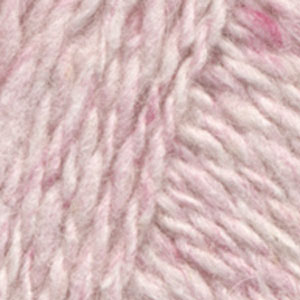







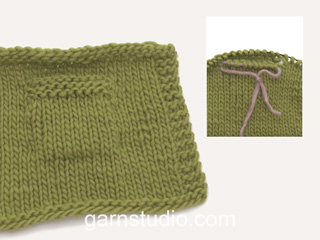

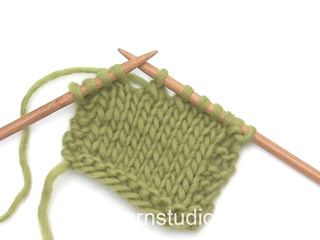



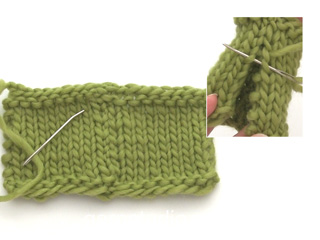

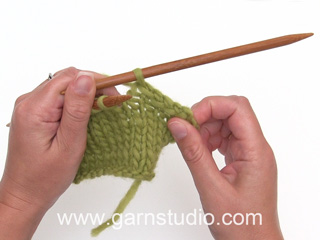
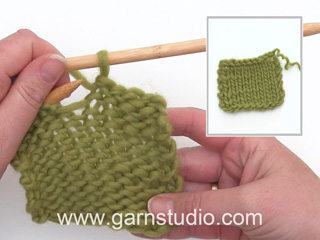
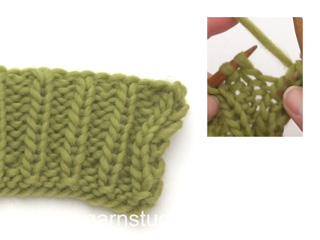

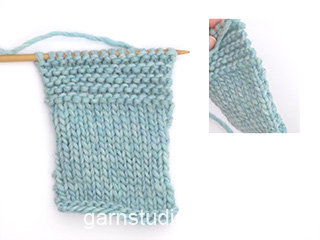
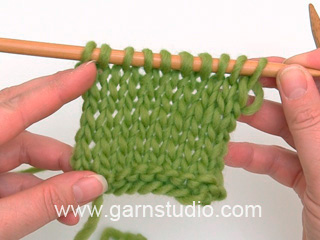














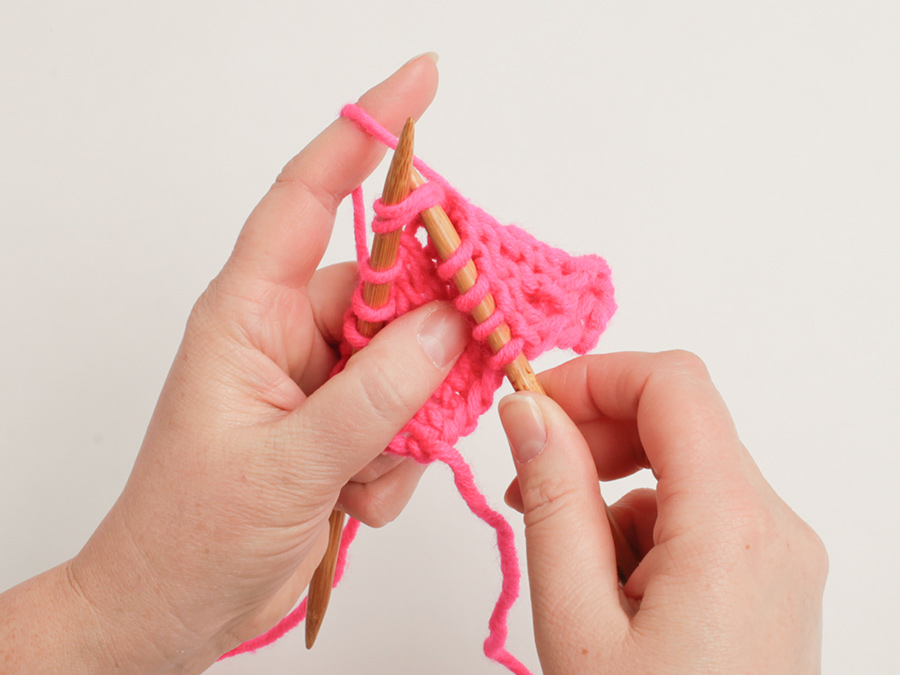








Comments / Questions (5)
Bonjour, Vous devriez proposer à nouveau l'angora tweed. Elle est superbe !
03.01.2021 - 02:17Bom dia, tenho duvidas na gola....uma vez que se aumenta 2 malhas em cada carreira a 5m do rebordo e sendo o canelado 2 meia e 2 tricot o padrão não vai bater certo...podem explicar?
10.10.2020 - 11:31DROPS Design answered:
Boa tarde, Os aumentos são feitos antes/depois do canelado. Sendo assim, depois de se aumentar 1 malha, tricota-se essa malha em meia ou em liga, consoante a malha anterior do canelado (Ezemplo: a última malha do canelado é a 2.ª malha liga. Tricota a nova malha em meia). Vai criar um canelado em diagonal. Bons tricôs!
12.10.2020 - 16:12Hallo liebes Drops-Team, Bitte, können Sie sagen, wo finde ich die Tabelle mit den Körpermassen, die konkret SIE benurzem, damit ich richtige Kleidungsgröße ermitteln kann. Da es auch die Zugabe für die Bequemlichkeit überall gibt, ist es schwierig nur anhand den cm angaben auf der Schema zu folgen. Ich brauche für meine Mutter, die Brustoberweite 110 hat L..oder XL..? im internet bei jedem Hersteller eigene Bestimmung) Vielen Dank!
30.04.2019 - 16:08DROPS Design answered:
Liebe Viktoriya, am besten messen Sie eine ähnliche Jacke die Sie gerne haben, diese Massen vergleichen Sie mit den von der Maßskizze, so können Sie die richtige Größe wählen. Mehr über Größen lesen Sie hier. Viel Spaß beim stricken!
30.04.2019 - 16:58Guten Tag. Ich komme mit ihrer Beschreibung nicht weiter. Es geht immer noch um den Kragen. Wie stricke ich weiter wenn ich die 22 Maschen vom Hilfsfaden zurück auf die Nadel genommen habe. In der ersten Reihe meine ich. Wenn ich nur eine Masche innerhalb von 5 Maschen zunehmen soll,verschiebt sich doch das ganze Muster.Vielen Dank Peggy
07.09.2016 - 16:01DROPS Design answered:
Liebe Peggy, Sie müssen 1 M. auf beiden Seiten zunehmen (nicht nur auf 1 Seite sondern auf beiden, dh nach den 5 ersten Maschen und vor den 5 letzen Maschen. Diese Zunahmen werden in Bündchen gestrickt: die erste Zunahme stricken Sie li., die 2. Zunahmen stricken Sie auch li. (= 2. ZunahmeR) = nach 12 R. haben Sie wieder 2 re./2 li. Dann stricken Sie die nächste 2 Zunahme re. = nach weitere 12 R haben Sie wieder 2 re./2 li. und so weiter zunehmen: die 2 nächste li, die 2 nächste re, usw.
08.09.2016 - 08:46Können Sie mir bitte den Teil mit dem Kragen erklären,nachdem man die 22 Maschen von dem Hilfsfaden auf die Nadel zurückgelegt hat? Ich verstehe das mit den Aufnahmen nicht .Hab schon mit der 1.Reihe wo man innerhalb der 5 M.die 6M.aufnehmen soll . Und wie geht dann das Bündchenmuster auf? Hänge total in der Luft und kann nicht weiter stricken. Danke für die schnelle Hilfe.
05.09.2016 - 12:32DROPS Design answered:
Liebe Peggy, die aufgenommenen Maschen sollen in Bündchen gestrickt werden: die 2 ersten M. werden li. gestrickt die 2 nächsten M. rechts u.s.w.
05.09.2016 - 13:40